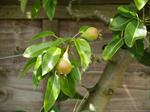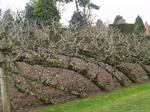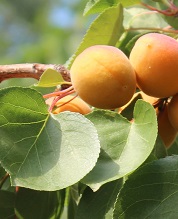 Learn Fruit Growing and Orchard Management
Learn Fruit Growing and Orchard Management
Are you serious about fruit growing? Think that you may have good opportunities if only you knew more?
- Commercial or small scale production
- Start studying any time
- Study from anywhere at your own pace
Start a Fruit Farm, Get a job in the Fruit Industry or Improve an existing orchard
- Course Duration: 100 hours
- Assignments: 8
- Exams: 1
COURSE STRUCTURE
There are 8 lessons as follows:
- Introduction to Temperate Fruit Growing
- Deciding What to Grow
- Crop Selection Criteria
- Options of Types of Fruits: Citrus, Berries, Vine Fruits, Pome Fruits, Stone Fruits, Nuts, etc
- The Botany of a Fruit and Fruit Development
- The Flower and Inflorescence
- Types of Fruit: simple, aggregate, multiple
- Modification of Fruits
- How Seed Forms, Buds
- Terminology
- Morphological Changes in Plants
- Establishing an Orchard
- Considerations when Establishing an Orchard
- Site Selection; size, location, climate, water, pest and disease exposure, etc
- Calculating Effective Rainfall
- Drawing an Orchard Plan
- General Cultural Practices
- Understanding Soils
- Physical Soil Characteristics; soil texture, structure, etc
- Chemical Characteristics of Soil; pH, Nutrition
- Soil Water
- Simple Soil Tests
- Dealing with Fruit Tree Problems
- Identifying a Problem
- Pests; chewing insects, sucking insects, other pests, birds
- Diseases; fungal, virus, bacterial
- Integrated Pest Management (IPM)
- Chemical Pest Control
- Non Chemical Pest Control
- Common Environmental Problems
- Staking Plants, Cages and tree guards
- Weed Control
- Nutrition and Plant Feeding
- Pruning Fruit Trees
- Pruning Systems
- Water, Drainage andIrrigation
- Tree Fruits
- Deciduous Fruit Trees
- Winter Chilling Requirements
- Climate Needs
- Choosing Varieties
- Pollination Needs
- Growing Apples
- Apricot
- Cherry
- Fig
- Loquat
- Asian Pear or Nashi
- Olive
- Peach and Nectarine
- Pear, Plum
- Pepino, Pomegranate, Quince, Tree Tomato
- Using Compost
- Vines, Nuts and Berries
- Nut Growing Introduction
- Walnut Culture
- Chestnut, Almond, Macadamia, Pecan, American Hazlenut, Filbert, etc.
- Passion-fruit Culture
- Chinese Gooseberry
- Grape Cultivation
- Overview of Berry Fruit Growing
- Strawberry Growing
- Raspberry, Cape Gooseberry, Mulberry, Blueberry, Elderberry, Currants, Cranberry, Brambles
- Citrus
- Introduction to Citrus Culture
- Overview of Species
- Temperature Tolerance
- Culture and Planting Citrus
- Citrus Problems and treatments
- Citrus Directory; review of main types
- Cultural Management of a Fruit Plantation or Orchard
- Developing a Maintenance Program
- The Production Plan
- Producing a Flow Chart (Timetable) for a crop
- Marketing Your Produce
- Introduction
- Marketing Options
- Conducting Market Research
- Standards; quality, quantity, cost efficiency
- Sales Price
- Example of Harvest and Post Harvest treatment of a Crop
Each lesson culminates in an assignment which is submitted to the school, marked by the school's tutors and returned to you with any relevant suggestions, comments, and if necessary, extra reading.
AIMS
- Identify different types of fruit crops, which can be successfully grown in the learner's region.
- Explain the nature of the fruit industry in the learner's region (locality).
- Determine the cultural requirements for different fruit crops.
- Develop a plan for the establishment of an orchard.
- Formulate appropriate methods for marketing specific fruit crops grown in the learner's locality.
- Develop a calendar for cultural management of a fruit plantation, or orchard.
 How to Successfully Grow Fruit
How to Successfully Grow Fruit
Successful Fruit Growing depends upon many things, including:
- A knowledge of horticultural methods and techniques, from soil to pest management and watering to pruning practices.
- Experience -some people learn by working with others, perhaps as a volunteer, perhaps in a paid job. Others gain experience by networking, getting involved with organisations involved in growing fruit. Yet others learn through trial and error, and by making mistakes.
- Plant knowledge -an ability to choose the best varieties to grow for the location you are using
- For a successful commercial fruit farm, you also need a measure of business skill (eg. farmers who can manage people, equipment, marketing and finance may often do better even if their horticultural skills are not quite as good).
- Luck and Timing - Things such as weather conditions, changes in market supply and demand, etc cannot be controlled; and yet, they always impact heavily upon the value of the fruit crop you grow.
Getting Help
There are numerous organisations and agencies which can be of great assistance to anyone growing a crop; whether experienced, or new to the job.
The place to start is your nearest ‘Department of Agriculture’ office, ‘Primary Industry’ or equivalent). In most state or national capital cities you can find is an ‘Agriculture Department’ office. To find the address and phone number of your nearest ‘Agriculture Department’ establishment look in the telephone book; or search the internet. Look in the section headed 'Government'. This will list some places for Department of Agriculture.
Scientific research bodies (both private and government) eg. university departments, government agricultural research stations. Once again search either the phone book or internet.
Professional associations can be very helpful when entering into a new field, horticulture or anything else. There are general associations such as an Institute of Horticulture, or the International Society of Horticultural Science; or more specific organisation fruit growers. Many such bodies will accept student members; something you should consider and while undertaking this course.
The school can provide advice and contacts for joining such a body while you are studying.
Field days and agricultural shows are places where you can get a wealth of knowledge and assistance if you are starting out in a new profession - or even just commencing to grow something new for your own use. Departments of Agriculture, Horticultural schools and colleges or people involved in working in the field should be able to tell you something of what field days or shows are on and when they are on.
If you are serious about the crop or crops you are going to grow, it is essential that you should maintain an effort to keep yourself informed. Know about the latest products and techniques; market trends; new crop varieties. To keep yourself up to date you have to maintain contact with the people and organizations that make up the industry.

WHY DO WE FREQUENTLY GROW GRAFTED FRUIT TREES?
Most deciduous, and many evergreen fruit trees are sold as grafted plants. Grafted trees always have an advantage, but the advantage may vary from place to place and between different types of trees. Sometimes grafting is essential to produce trees that are hardy enough for the place you are growing them; and sometimes, grafting simply results in a better quality or quantity of harvest.
Grafting involves joining two different closely related varieties of plants, together. The roots (rootstock) are one variety, and the top of the plant (scion) is a different variety. A peach tree for example, may have a delicious tasting fruit variety growing above ground, and a more vigorous variety that is resistant to root diseases, growing below ground. The root system variety may only produce very small, poor tasting fruit but because it has a superior root system, when grafted onto the scion of another species it can support the top of the tree better than would be possible if the top grew on its own roots.
Another marked advantage of grafted fruit trees is that it is possible to graft prolific scions onto dwarf rootstocks. You then produce low growing trees which are not only easier to harvest, but they are ideal for slotting into cramped spaces and urban gardens.
WHO CAN THIS COURSE BENEFIT?
This course is about building skills and knowledge - it benefits anyone serious about
horticulture.
If you are serious about fruit growing or want to learn more in order to see if this is right for you - then this is a great starting point. It covers all the basics you need from soils to marketing and by the end of the course you will be able to make informed decisions about where to go from there on.
If you are looking to set up a fruit growing concern, work
in one, or want to find work in that field or want to set up a fruit
orchard for your own use, or as a backyard business - then this course
is definitely going to help you towards that goal.
- Those working in an orchard.
- Thoe who want to further develop their skills by learning from experts with years of industry knowledge.
- Those setting up an orchard or fruit growing enterprise.
- Those who would like to develop more knowledge for their own backyard production.